
Showing posts 11 - 15 of 177 matching: history
Monday, June 13, 2022
This Day in History: Tough on Crime
If you've seen any movie filmed in New York City during the 1970s and 80s, you know that town was an absolute cesspool overflowing with garbage and urban blight. Thankfully, one visionary man bucked the system, seized power, and began cleaning up the city in the mid 1990s.
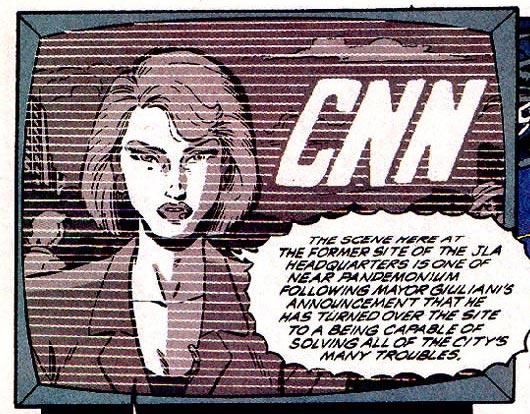
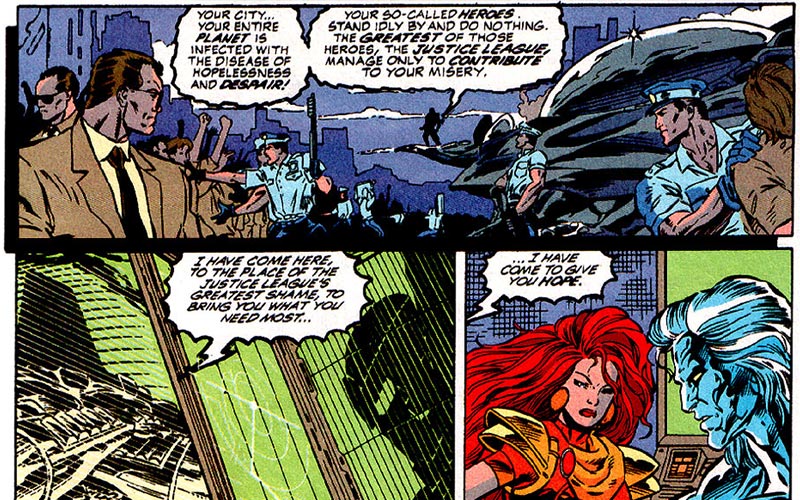
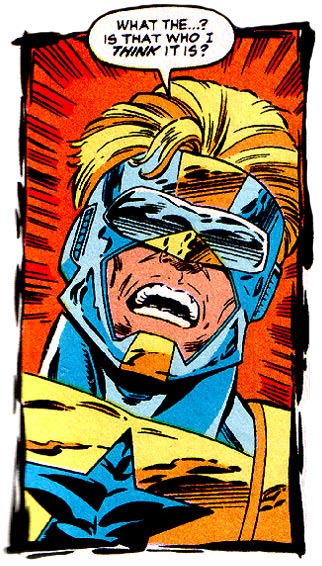
Yes, Booster. That man was the dictator Monarch. And readers of Extreme Justice #7, released on this date in 1995, would have recognized him as a wolf in sheep's clothing. Therefore, the question at the heart of this story isn't whether or not the familiar Monarch had become a sheep, but just which wolf he was.
First, a bit of backstory. Debuting in Armageddon 2001 #1 (1991), Monarch was a corrupted hero who had grown so frustrated at how bad the world was being run, he was determined to take it over himself. The time-traveling would-be world dictator (co-created by former Marvel Comics editor-in-chief Archie Goodwin with shades of Doctor Doom and Kang the Conqueror) had already had run-ins with almost every super hero on Earth.
What makes Monarch particularly unique in the DC Universe isn't the character's origins or motivations, but his very complicated relationship with Captain Atom. See, as originally planned, Monarch *was* Captain Atom. DC's writers and artists seeded clues to Monarch's true identity for months, but when news of the planned reveal leaked to the general public, editors made a last-minute change to his secret identity.
However, no one liked the change (perhaps because of all the strong clues already in print to the contrary), and thus would begin years of stories revising Monarch's identity and intentions. Stories like this one.
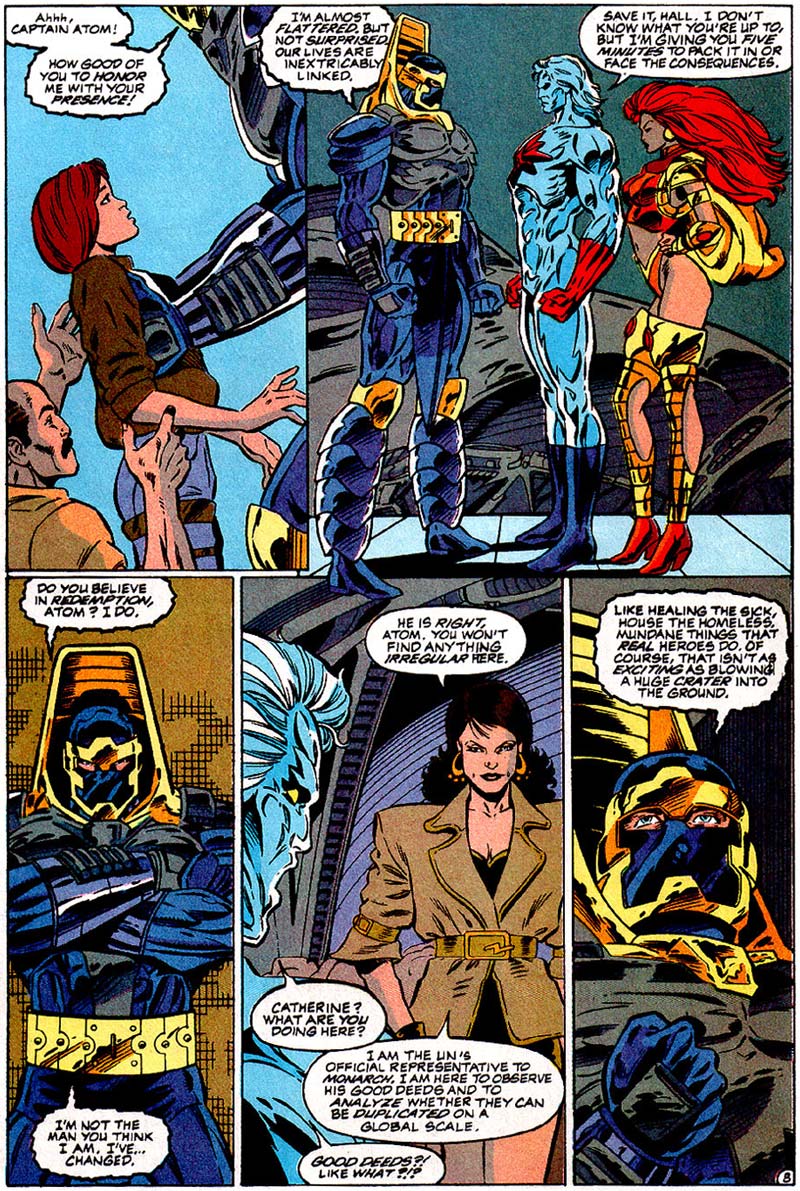
Those who remember Extreme Justice often remember the "extreme" art, which makes it easy to say that the strength of the series was writer Dan Vado's character-driven melodramas and morality plays. What is the cost of being a hero? What defines a villain? Who are we all, really? This issue doesn't answer those questions, but life is about the journey, not the destination.
Just remember to never, ever trust a tyrant like Monarch.

Especially not if your name is Booster Gold.
Comments (0) | Add a Comment | Tags: blue beetle captain atom dan vado extreme justice monarch
Friday, June 3, 2022
A History of Crises
When Dark Crisis arrives next week, it will be only the latest nearly-annual DC Universe-threatening event in a series stretching back nearly four decades to the incredibly influential Crisis on Infinite Earths in 1985, which also happens to be the same year a young hero named Booster Gold first made the scene.
Therefore, now seems a good opportunity to look back at how each annual mini-series event has affected Booster's career.
- Crisis on Infinite Earths (1985)
Debuting in Booster Gold #1, Booster Gold was the first hero to appear in the new DC Universe following the resolution of the greatest Crisis of all crises. - Legends (1986)
The anti-hero sentiment stirred up by Glorious Godfrey motivates a mob to attack a hospitalized Booster Gold in Booster Gold #13. Booster will flee to the future for medical help and return to the 20th century with his twin sister. - Millennium (1988)
As motivation to force him to join their cause, the Manhunters steal Booster's fortune in Booster Gold #24 and nearly drive him into early retirement. In the aftermath, we learn that Booster is an important link in the future evolution of the human race. He will stop working solo and join the Justice League International full time alongside a fellow hero in a similar situation, Blue Beetle. - Invasion! (1989)
Booster and the rest of the Justice League International join the heroes of the world in striking against the alien alliance in Invasion! #2. Later, as two of the technology-based heroes unaffected by the detonation of the alien gene bomb, Booster Gold and Blue Beetle help keep the peace in New York City. His experiences on the islands of the Pacific Ocean during the invasion will open the door to a series of bad judgements and misfortunes that will ultimately drive Booster to quit the team. - Armageddon 2001 (1991)
Booster takes a temporary leave of absence from leading his new, corporate-sponsored team, the Conglomerate, to aid a Justice League in disarray against Monarch in Armageddon 2001 #2. - War of the Gods (1991)
Once again, the heroes of the world — including Booster Gold — join in another strike force, this time against the gods of New Olympus in War of the Gods #4. - Eclipso: The Darkness Within (1992)
Once again, the heroes of the world — including Booster Gold and the recently reformed Justice League International — join in another strike force, this time on the moon against the demigod Eclipso in Eclipso: The Darkness Within #2. - Bloodbath (1993)
Having previously lost his 25th-century technological powers to Doomsday, Booster tests his replacement armor against the powerful alien parasites in Bloodbath #1. - Zero Hour: Crisis in Time (1994)
The time-manipulating Extant erases Booster from history in Zero Hour #1. When the timeline is restored, Booster Gold and his pal Blue Beetle will join a splinter group of the Justice League dedicated to taking a more proactive, "extreme" approach to defending the world against future threats. - Underworld Unleashed (1995)
Teammates Booster Gold and Blue Beetle help keep the peace in Metropolis during the demon Neron's supernatural famine in Underworld Unleased #3. - The Final Night (1996)
Booster and Beetle are as powerless as everyone else to restart the sun in The Final Night #3. - Booster plays no role in Genesis (1997), DC One Million (1998), or Day of Judgement (1999).
- Our Worlds at War (2001)
Booster and other former Justice League International members fight a nigh-omnipotent Imperiex Probe to the death in JLA: Our Worlds at War #1. - Joker: Last Laugh (2001)
During the chaos of Joker's attempt to poison the world, Booster Gold is turned into a pig by the witch Circe in Wonder Woman #175. - Identity Crisis (2004)
Booster attends the funeral of Sue Dibny in Identity Crisis #1. - Infinite Crisis (2005)
After his best friend, Blue Beetle, is killed by the villainous Checkmate in Countdown to Infinite Crisis, Booster Gold goes to the future and restores his long-lost armor, then seeks out Beetle's successor and leads him against the evil Brother Eye artificial intelligence. In the crisis's aftermath, Booster will join Time Master Rip Hunter to save the newly reborn multiverse (in 52). - Final Crisis (2008)
Booster attends the funeral of Martian Manhunter in Final Crisis: Requiem #1. In the crisis's aftermath, Booster will join other Time Masters in hunting Batman, who has been lost in history (in Time Masters: Vanishing Point). - Blackest Night (2009)
Possessed by the Black Lantern of Nekron, the deceased Blue Beetle rises from the grave to attack both his successor and Booster Gold in Booster Gold #26. In the crisis's "Brightest Day" aftermath, Booster will rejoin his old Justice League International allies in hunting down Blue Beetle's reanimated killer (in Justice League: Generation Lost). - Flashpoint (2011)
Cut off from his allies, Time Master Booster Gold fights alone to repair the damaged DC Universe timeline in Booster Gold #45. Despite his best efforts, he fails. In the "New 52" timeline established afterwards, Booster will become the leader of a reimagined Justice League International (in Justice League International). - Futures End (2014)
Booster Gold becomes unstuck in time in Booster Gold: Futures End #1 and is manipulated into putting the entire Multiverse in jeopardy. - Convergence (2015)
The Booster Golds of two different universes collide in Convergence Booster Gold #1. One becomes the new Waverider and uses his newfound power to help undo the damage he caused. These newest changes set in motion new events that will eventually lead to the eventual unravelling of the "New 52" timeline and a reunifying "Rebirth" of pre-Flashpoint history. - Booster plays no role in Rebirth (2016) or Dark Nights: Metal (2017).
- Heroes in Crisis (2018)
After the ramifications of a series of time-travel misadventures drive a traumatized Booster Gold to seek mental help, he is accused of murdering the other patients in his superhero care facility in Heroes in Crisis #1. Booster escapes capture and proves his innocence with the aid of his recently reborn best friend, Blue Beetle. - Doomsday Clock (2019)
In the aftermath of the universal rebirth, once again the heroes of the world — including Booster Gold — join in another strike force, this time against the menace responsible for the "New 52," Doctor Manhattan, on Mars in Doomsday Clock #9. - Year of the Villain (2019)
The Dark Multiverse's The Batman Who Laughs continues his assault on the heroes of Earth by spreading his evil infection to an unsuspecting Booster Gold in Hell Arisen #2. He will eventually be rescued by Lex Luthor. - Dark Nights: Death Metal (2020)
All the heroes and villains of the world — including Booster Gold — join in another strike force, this time against the Batman Who Laughs' multiverse-devouring master, Perpetua, in Dark Nights: Death Metal #5.
That's a lot of drama! Will Dark Crisis be a boon or a bane for Booster Gold? We'll start finding out next week.
Comments (4) | Add a Comment | Tags: dark crisis events
Friday, May 27, 2022
This Day in History: The End of Convergence
If you're starting to feel like tragic events are repeating themselves over and over, you might be a DC Comics reader.
In 1985, the original Crisis on Infinite Earths destroyed the DC Multiverse. Twenty years later, Infinite Crisis revisited the same territory and partially restored the DC Multiverse. Ten years after that, Convergence revisited the same territory and revealed that the DC Multiverse had existed in our hearts all along.
That was 7 years ago today.
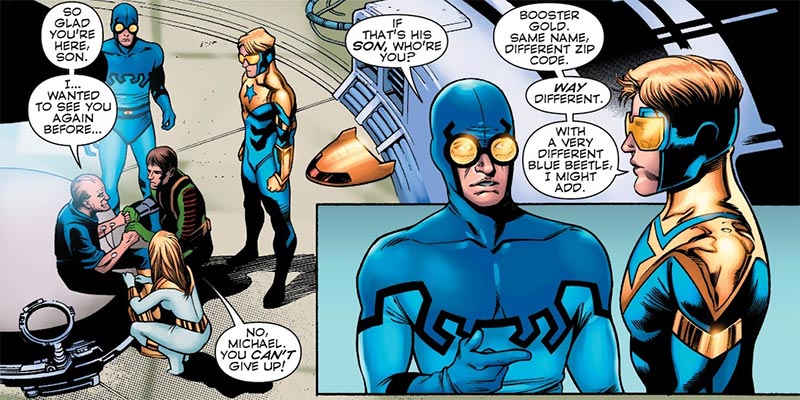
It was in the pages of Convergence Booster Gold #2, released May 27, 2015, that we learned that the Booster Gold who appeared in the New 52 Justice League International was not actually the same person who had appeared in two volumes of comics named Booster Gold.
And it was also in the pages of Convergence Booster Gold #2 that the original Booster Gold died and was brought back to life as the newest Waverider.
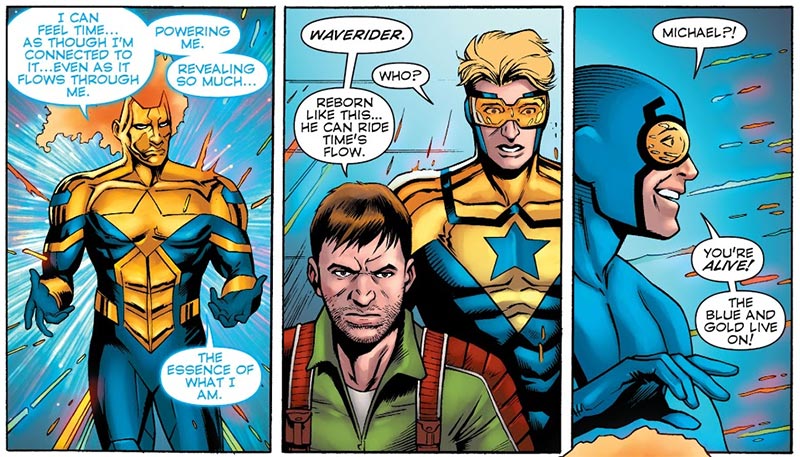
That happened just in time for Waverider to arrive and help save the day in Convergence #8, also released May 27, 2015. How did he help? By empowering Brainiac, the very same creature who had caused the Convergence in the first place.
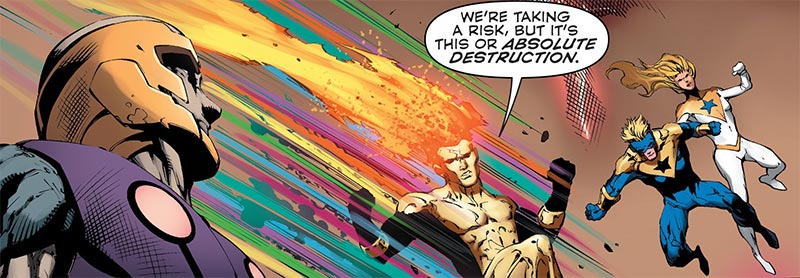
The reality created by Convergence lasted barely a year before Doctor Manhattan's tinkering in DC Universe: Rebirth resulted in awkward merging the pre- and post-New 52 realities to create a whole new continuity lying somewhere in between, a reality that has since been revised in Death Metal and is again being challenged in this summer's Dark Crisis.
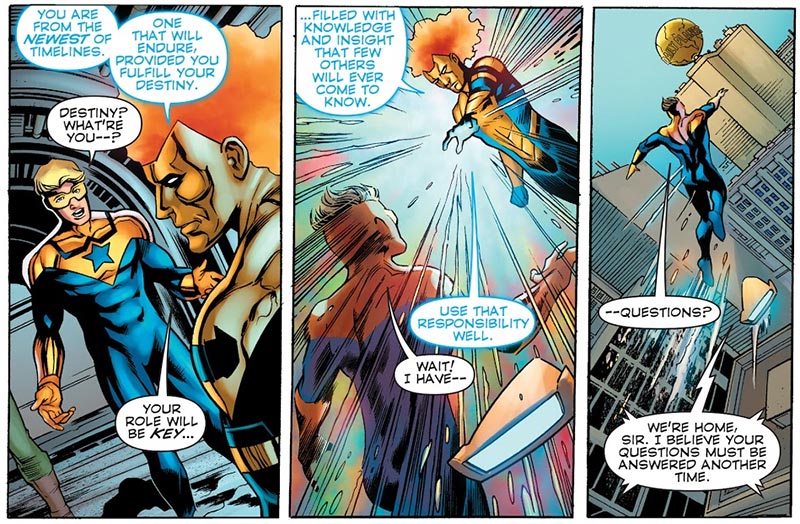
Like I said, sometimes reading DC Comics is like being caught in a cosmic hamster wheel of trauma, a wheel that seems to be spinning faster and faster the longer we're on it.
However, the important lesson isn't that the multiverse is full of evil. The lesson is that every time evil rears its head, heroes will emerge to fight it.
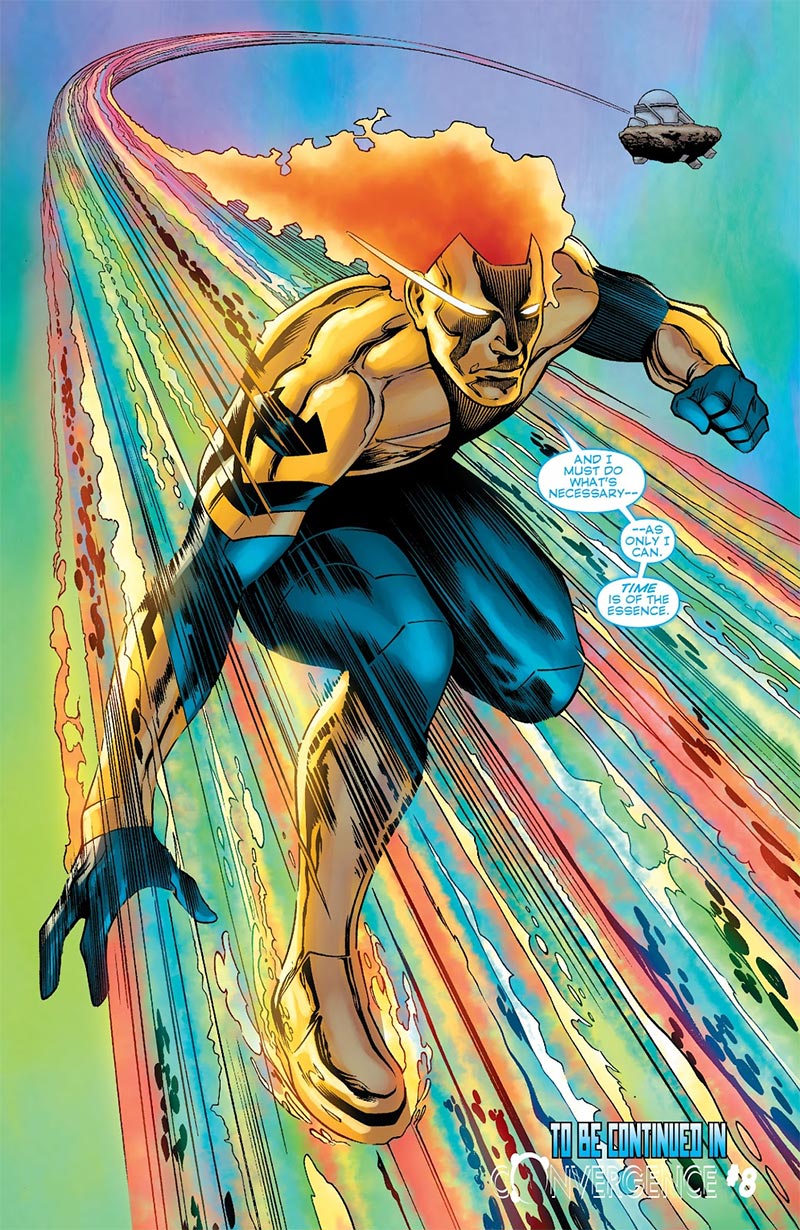
Such is life in every universe.
Comments (4) | Add a Comment | Tags: convergence waverider
Friday, April 22, 2022
All Better Now
In comic books, heroes arrive in the nick of time to restore the status quo. That's generally what you want when a crime is being committed. But what if the problem is the status quo itself?
That's why the first Earth Day was organized on April 22, 1970 (as any environmentally conscious time-traveler could tell you).
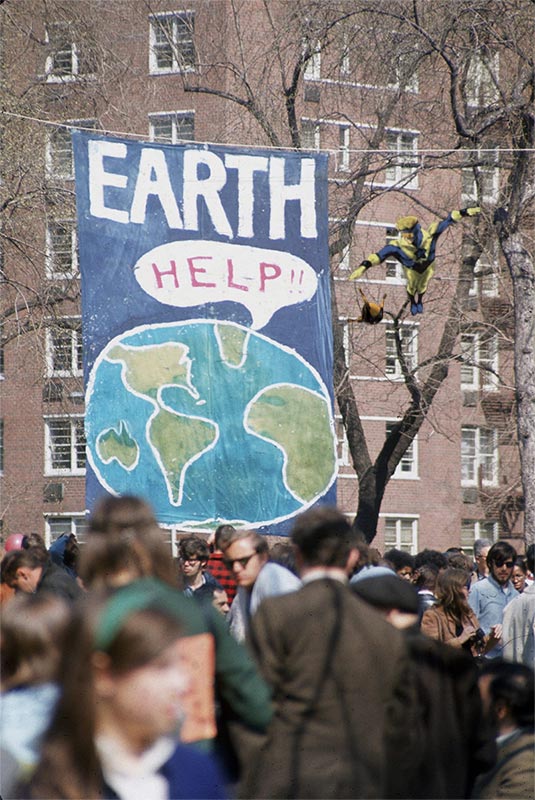
Most of us have only one Earth, and all things being equal, it has treated us pretty well so far. The least we can do is try to keep it the kind of planet our heroes would be proud to call home.
Comments (0) | Add a Comment | Tags: earth day secret history
Wednesday, January 12, 2022
Or Your Money Back
On January 9, 1969, during a ceremony in which he received the Miami Touchdown Club's F.A.M.E. (Football Awards Miami Edition) Award for the Most Outstanding Professional Football Player of 1968, quarterback Joe Namath of the New York Jets was confronted by an aggressive Baltimore Colts fan. In response to the taunting, Namath guaranteed a Jets victory in the upcoming Super Bowl III.
It became the guarantee heard around the world.
Smart money at the time was that the Colts, representing the established National Football League (whose teams had won the previous two Super Bowls decisively), would handily beat the Jets of the upstart American Football League. No less than famous oddsmaker Jimmy the Greek had predicted the Colts would win by more than two touchdowns.
Therefore, Namath's guarantee, widely reported by the Miami Herald, was generally ignored or ridiculed.
As you may have heard, when the game was played on January 12, the Jets not only covered the 17-point spread, they won outright, proving that the AFL was legitimate football and paving the way for the Super Bowl to become America's biggest sports spectacle. As Namath left the field that day, "The Guarantee" became legend...
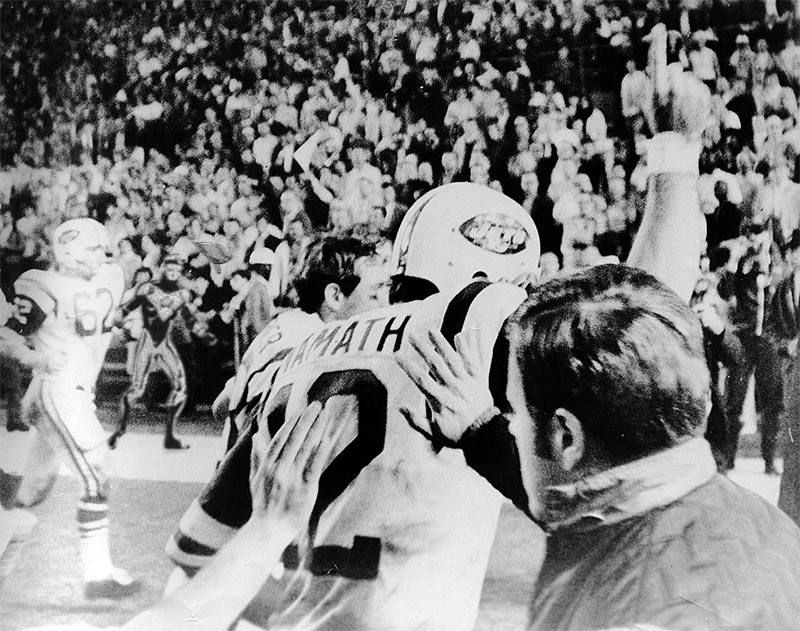
...the sort of legend that time-traveling, 20th-century hero-worshiping, former-football-players (with problematic gambling histories) probably find irresistible.
Comments (1) | Add a Comment | Tags: football joe namath secret history
SITE SEARCH
SPOILER WARNING: The content at Boosterrific.com may contain story spoilers for DC Comics publications.
Booster Gold, Skeets, and all related titles, characters, images, slogans, logos are trademark ™ and copyright © DC Comics unless otherwise noted and are used without expressed permission. This site is a reference to published information and is intended as a tribute to the artists and storytellers employed by DC Comics, both past and present. (We love you, DC.) Contents of this page and all text herein not reserved as intellectual property of DC Comics is copyright © 2007-2024 BOOSTERRIFIC.com. This page, analysis, commentary, and accompanying statistical data is designed for the private use of individuals and may not be duplicated or reproduced for profit without consent.




